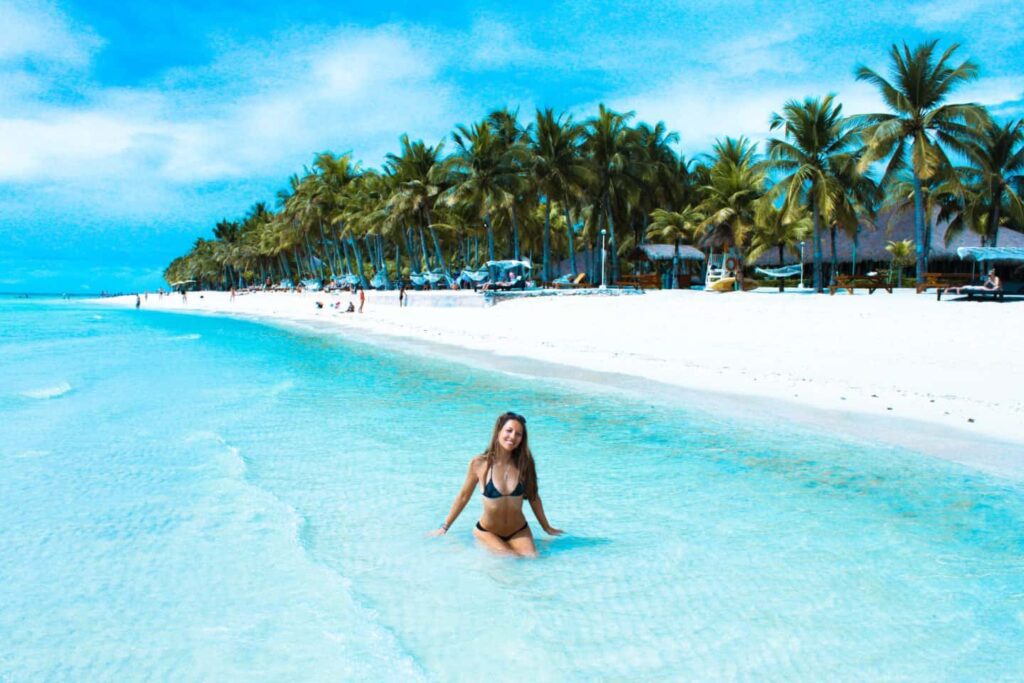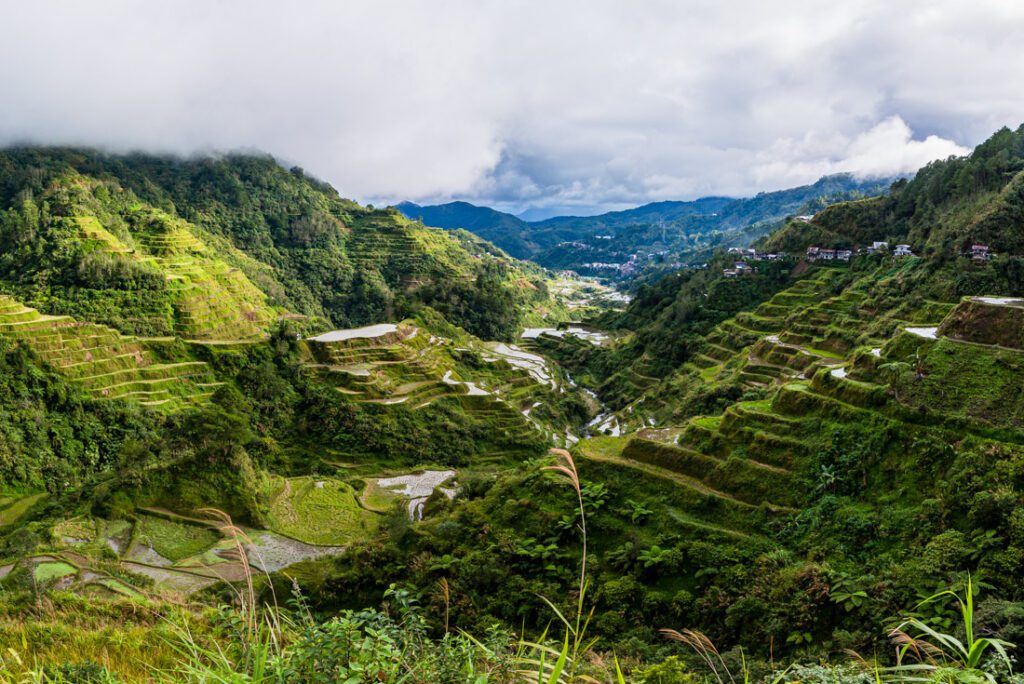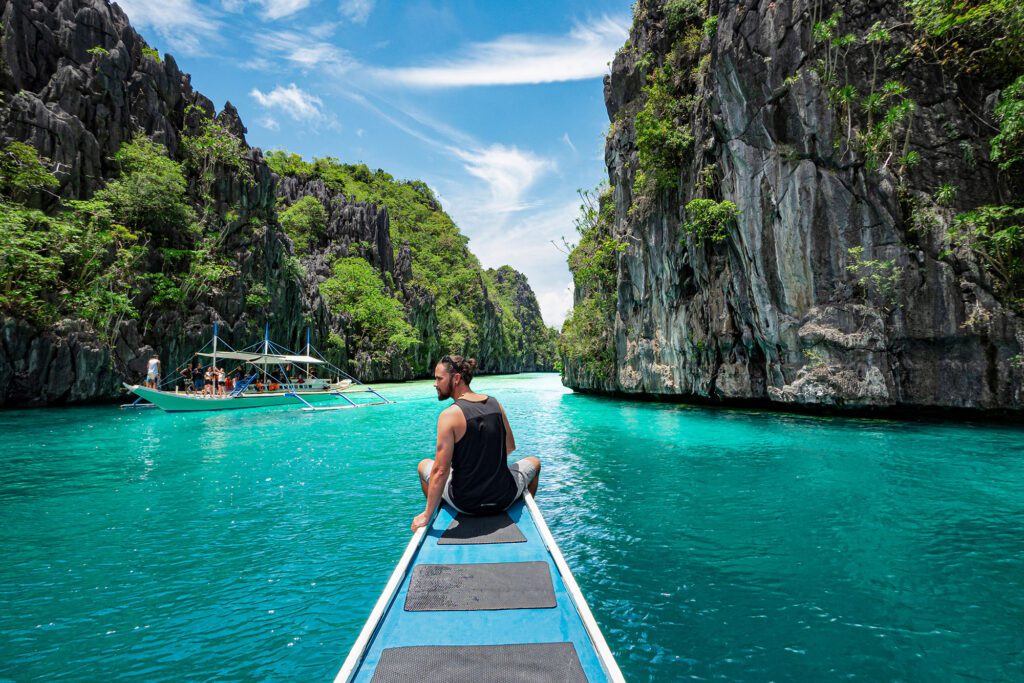Philippines
The Philippines, located in Southeast Asia, is the world’s second-largest archipelago at the western edge of the Pacific Ocean. It is a magical world of over 7,000 islands, of which only 2,000 are inhabited. All the islands are mountainous, and most are covered in wild jungle.
They contain 21 active volcanoes, and their most significant feature is a beautiful coastline, one of the longest in the world. Clear waters, a tropical climate, breathtaking reefs, and underwater marine life make the Philippines a true paradise for diving and snorkeling enthusiasts, and a key highlight in any Philippines Travel Guide.
For most travelers, the itinerary in the Philippines begins in Manila, continuing through the islands of Tagaytay, Pagsanjan, Banaue, Sagada, Vigan, and Palawan. After visiting the island of Luzon, it is recommended to continue to the central Philippines, to the Visayas islands.
For the more energetic, the Philippine islands offer mountain and cliff climbing, trekking, wildlife and vegetation observation, and cave exploration. The three main island groups, which form the basis of most travel planning, are: the Luzon islands, which include Luzon, the most significant and northernmost island.
Palawan, Mindoro, and other smaller islands; the Visayas group, which includes many islands, the most famous of which is Boracay; and the western province of Palawan. This pristine and wild region, often featured in a Philippines Travel Guide, also offers travel opportunities, nature exploration, beautiful landscapes, and some of the best diving sites in the Philippines.
Articles and Guides about Philippines
Frequently Asked Questions about Philippines
The best time to visit the Philippines is during the dry season, which typically runs from November to April. During these months, you’ll experience less rainfall, lower humidity, and calmer seas, making it ideal for island hopping, diving, and beach activities. The wet season, or typhoon season, is from May to October.
Your budget will depend heavily on your travel style. Here’s a rough guide per person, per day:
- Budget Traveler: $30 – $40 USD (staying in hostels, eating at local eateries, using public transport).
- Mid-Range Traveler: $60 – $90 USD (staying in private hotel rooms, dining in restaurants, taking occasional domestic flights and taxis).
- Luxury Traveler: $150+ USD (staying in resorts, enjoying fine dining, and using private transfers).
The official currency of the Philippines is the Philippine Peso (PHP), often denoted by the symbol ₱. While credit cards are widely accepted in major cities and tourist resorts, it’s highly recommended to carry enough cash, especially when traveling to smaller islands and rural areas where ATMs may be scarce.
Upon arrival, you can buy a local SIM card from providers like Globe or Smart at the airport. However, for a more convenient and modern solution, consider an eSIM. This allows you to activate a data plan on your phone the moment you land without needing to find a physical store. For reliable and easy-to-use plans, we recommend Saily>>
Yes, and we can’t stress this enough. Your trip to the Philippines should be about unforgettable adventures, not unexpected worries. Imagine diving into the pristine reefs of Palawan or trekking to a hidden waterfall—the freedom to fully embrace these incredible moments comes from knowing you’re covered if things don’t go as planned.
Think of travel insurance as your essential partner for true peace of mind, protecting you from trip cancellations, lost luggage, or unexpected medical needs in a remote location. It’s the one thing you buy hoping you’ll never need, but it ensures your dream vacation doesn’t turn into a nightmare. Don’t leave it to chance.
Yes, and we can’t stress this enough. Your trip to the Philippines should be about unforgettable adventures, not unexpected worries. Imagine diving into the pristine reefs of Palawan or trekking to a hidden waterfall—the freedom to fully embrace these incredible moments comes from knowing you’re covered if things don’t go as planned.
Think of travel insurance as your essential partner for true peace of mind, protecting you from trip cancellations, lost luggage, or unexpected medical needs in a remote location. It’s the one thing you buy hoping you’ll never need, but it ensures your dream vacation doesn’t turn into a nightmare. Don’t leave it to chance.
If you’re planning to explore the larger islands like Luzon, Cebu, or Mindanao, renting a car is one of the best ways to travel freely and comfortably. Main roads are generally in good condition, and driving outside the big cities is fairly easy. Having your own car gives you full flexibility to stop at hidden beaches, mountain viewpoints, and local villages whenever you wish.
Public transportation in the Philippines is diverse and convenient — from domestic flights to long-distance buses and ferries connecting major islands. You can easily plan and book your trips between cities or islands through platforms like Omio, which lets you compare prices, schedules, and travel options all in one place.
👉 Explore transport options in the Philippines with Omio>>
Philippines - The Short Guide
Weather in the Philippines
The Philippines is a vast tropical archipelago with distinct weather patterns across its 7,000+ islands. Unlike temperate countries, the Philippines generally has two main seasons: the dry and wet seasons. Understanding these will help you plan the perfect trip.
Dry Season (November to April) This is the most popular time to visit the Philippines. With less rainfall and calmer seas, it’s the ideal period for island hopping, diving, and enjoying the world-class beaches of Palawan, Boracay, and Cebu. The months from December to February are slightly cooler and less humid, while March and April can get very hot and dry.
Wet Season (May to October). Also known as the typhoon season, this period brings increased rainfall and humidity. While travel is still possible and the landscapes are incredibly lush and green, there’s a higher chance of tropical storms disrupting flights and ferry schedules. The rice terraces in Banaue and the waterfalls throughout the country are particularly stunning during this time.
See the weather in the Philippines month by month >

Philippines Travel Guide – Flights to the Philippines
The Philippines is well-connected to the world through several major international airports. The busiest hub is Ninoy Aquino International Airport (MNL) in Manila, followed by Mactan-Cebu International Airport (CEB) in Cebu, and Clark International Airport (CRK). Other important gateways include airports in Davao (DVO) and Kalibo (KLO) for Boracay.
From these airports, travelers can easily catch domestic flights to reach countless destinations across the country, from the pristine islands of Palawan to the surfing hotspots of Siargao.
Philippines Travel Guide – What to Do in the Philippines
The Philippines is a land of natural wonders, offering a blend of adventure, relaxation, and unique culture. Travelers can go island hopping in the stunning lagoons of El Nido, see the iconic Chocolate Hills in Bohol, or swim with whale sharks in Cebu. Nature lovers can trek to the ancient Banaue Rice Terraces, surf the famous Cloud 9 wave in Siargao, or dive among WWII shipwrecks in Coron.
For those seeking relaxation, the powdery white sands of Boracay and the secluded beaches of Palawan are ideal. The country’s festivals, like Sinulog in Cebu, fill the islands with vibrant music and dance. Its cuisine is a savory mix of sweet, sour, and salty flavors, with must-try dishes like Adobo and Lechon.

What to Do in the Philippines with Kids
The Philippines is a fantastic family destination. Kids can enjoy snorkeling among colorful fish in Coron, seeing the tiny, wide-eyed tarsiers in their sanctuary in Bohol, or exploring the historical walled city of Intramuros in Manila on a bamboo bike. In Cebu, the Cebu Ocean Park is a popular attraction. The calm, shallow waters of Boracay’s White Beach and the various family-friendly resorts across the islands all offer great options for children.
Philippines Travel Guide – Recommended Itinerary in the Philippines
A classic 10 to 14-day itinerary could include:
Island Hopping Route
- Manila (1–2 days): Explore the historic Intramuros district, modern BGC.
- Palawan (4–5 days): El Nido or Coron for breathtaking island hopping tours, lagoons, and beaches.
- Cebu & Bohol (4–5 days): Swim with whale sharks, visit the Chocolate Hills, see the tarsiers.
Optional add-ons:
- Siargao for surfing and a laid-back vibe.
- Boracay is known for its world-famous beaches and nightlife.
- Banaue for trekking through ancient rice terraces.
- Vigan for a trip back to the Spanish colonial era.

Philippines Travel Guide – Where to Stay in the Philippines
The Philippines offers a vast range of accommodations for every traveler.
- Manila: Makati or BGC for luxury and convenience.
- El Nido & Coron: Beachfront bungalows and island resorts.
- Boracay: Luxury resorts on White Beach and boutique hotels.
- Cebu: City hotels or beach resorts on Mactan Island.
For something truly special, spend a night in an overwater bungalow in Palawan or an eco-lodge overlooking the rice terraces.
Shopping in the Philippines
Shopping in the Philippines is a delightful experience. Each region has its own specialties.
- Cebu is known for its dried mangoes and handcrafted guitars.
- Manila for high-end malls and bustling markets like Greenhills for pearls.
- Palawan for beautiful South Sea pearls and woven handicrafts.
- Vigan for antiques and pottery.
Bargaining (“tawad”) is common in local markets, but prices in malls are fixed. Look for unique handmade souvenirs that reflect the Philippines’ artistic heritage.

Philippines Travel Guide – Attractions in the Philippines
The Philippines’ attractions are centered on its incredible natural beauty and rich biodiversity.
- Natural highlights include the limestone cliffs and turquoise lagoons of El Nido and Coron in Palawan, the Chocolate Hills of Bohol, the perfectly cone-shaped Mayon Volcano, and the Banaue Rice Terraces.
- Cultural lovers can visit the UNESCO World Heritage City of Vigan with its Spanish colonial architecture or the historic San Agustin Church in Manila.
- Modern Philippines shines in the bustling, modern districts of Bonifacio Global City (BGC) and Makati in Metro Manila.
Whether you seek adventure, relaxation, or cultural immersion, the Philippines offers unforgettable experiences.
Philippines Travel Guide – Top Destinations in the Philippines
- Manila – The Historic Capital Manila blends colonial history with modern energy. Explore the walled city of Intramuros, visit historic churches, and enjoy the vibrant food scene and nightlife in districts like Poblacion.
- El Nido – The Island Paradise Located in Palawan, El Nido is famous for its dramatic limestone cliffs, hidden lagoons, and pristine beaches. It’s the ultimate destination for island hopping.
- Cebu – The Queen City of the South. Cebu is a central hub that blends historical sites with natural attractions. Visit Magellan’s Cross, swim with whale sharks in nearby Oslob, and use it as a gateway to other Visayan islands.
- Boracay – The Coastal Escape Boracay is world-famous for its stunning White Beach, with powdery sand and clear blue water. It’s perfect for relaxation, water sports, and a vibrant nightlife scene.
- Siargao – The Surfing Capital Known for its legendary “Cloud 9” wave, Siargao offers a laid-back, bohemian vibe. Beyond surfing, you can explore rock pools, lagoons, and lush coconut palm forests.
- Bohol – The Natural Wonder Bohol is home to the unique Chocolate Hills and the adorable Philippine Tarsier. It offers a mix of jungle adventures, river cruises, and beautiful beaches on nearby Panglao Island.
Philippines Travel Guide – Travel Essentials
- SIM Card: Stay connected from day one with Saily, affordable eSIM plans that work instantly across the Philippines.
- Transfers: Book reliable airport-to-hotel transfers with KiwiTaxi, fixed prices, verified drivers, and comfort guaranteed.
- Insurance: Protect your trip with VisitorsCoverage, comprehensive travel insurance trusted worldwide.

